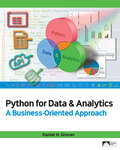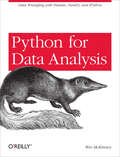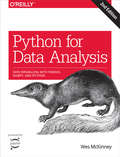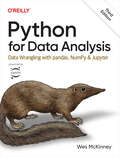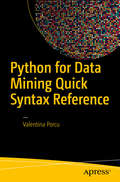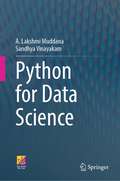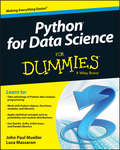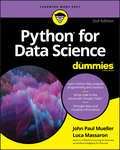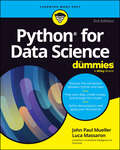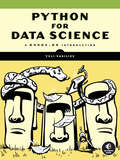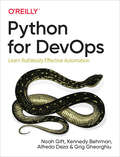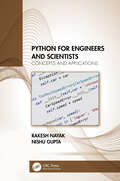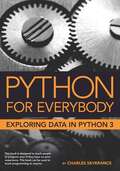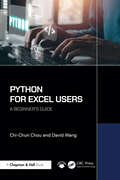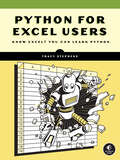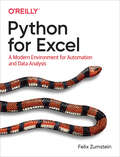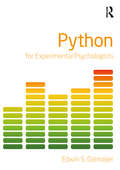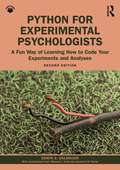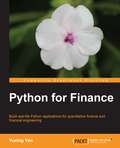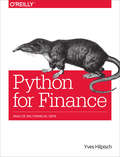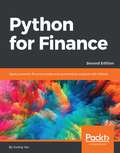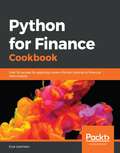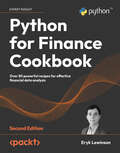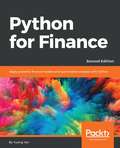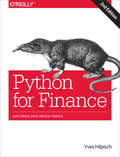- Table View
- List View
Python for Data & Analytics: A Business-Oriented Approach
by Daniel H. GronerPython for Data & Analytics introduces essential programming concepts using Python, pandas, and other packages for the purpose of accessing data, performing analyses, and developing applications. The presentation presumes no prior programming experience. It is designed for introductory and more advanced programming courses in a data analytics, information systems, or business program. To this end, business examples are emphasized throughout. Various topics often covered in a computer-science-oriented course are purposefully not included in this textbook including topics like recursion and sorting algorithms.
Python for Data Analysis
by Wes Mckinney<p>Despite the explosive growth of data in industry after industry, learning and accessing data analysis tools has remained a challenge. This pragmatic guide demonstrates the nuts and bolts of manipulating, processing, cleaning, and crunching data with Python. It also serves as a modern introduction to scientific computing in Python for data-intensive applications.</p>
Python for Data Analysis: Data Wrangling with Pandas, NumPy, and IPython (Oreilly And Associate Ser.)
by Wes MckinneyGet complete instructions for manipulating, processing, cleaning, and crunching datasets in Python. Updated for Python 3.6, the second edition of this hands-on guide is packed with practical case studies that show you how to solve a broad set of data analysis problems effectively. You’ll learn the latest versions of pandas, NumPy, IPython, and Jupyter in the process.Written by Wes McKinney, the creator of the Python pandas project, this book is a practical, modern introduction to data science tools in Python. It’s ideal for analysts new to Python and for Python programmers new to data science and scientific computing. Data files and related material are available on GitHub.Use the IPython shell and Jupyter notebook for exploratory computingLearn basic and advanced features in NumPy (Numerical Python)Get started with data analysis tools in the pandas libraryUse flexible tools to load, clean, transform, merge, and reshape dataCreate informative visualizations with matplotlibApply the pandas groupby facility to slice, dice, and summarize datasetsAnalyze and manipulate regular and irregular time series dataLearn how to solve real-world data analysis problems with thorough, detailed examples
Python for Data Analysis: Data Wrangling with pandas, NumPy, and Jupyter
by Wes McKinneyGet the definitive handbook for manipulating, processing, cleaning, and crunching datasets in Python. Updated for Python 3.10 and pandas 1.4, the third edition of this hands-on guide is packed with practical case studies that show you how to solve a broad set of data analysis problems effectively. You'll learn the latest versions of pandas, NumPy, and Jupyter in the process.Written by Wes McKinney, the creator of the Python pandas project, this book is a practical, modern introduction to data science tools in Python. It's ideal for analysts new to Python and for Python programmers new to data science and scientific computing. Data files and related material are available on GitHub.Use the Jupyter notebook and IPython shell for exploratory computingLearn basic and advanced features in NumPyGet started with data analysis tools in the pandas libraryUse flexible tools to load, clean, transform, merge, and reshape dataCreate informative visualizations with matplotlibApply the pandas groupby facility to slice, dice, and summarize datasetsAnalyze and manipulate regular and irregular time series dataLearn how to solve real-world data analysis problems with thorough, detailed examples
Python for Data Mining Quick Syntax Reference
by Valentina PorcuLearn how to use Python and its structures, how to install Python, and which tools are best suited for data analyst work. This book provides you with a handy reference and tutorial on topics ranging from basic Python concepts through to data mining, manipulating and importing datasets, and data analysis.Python for Data Mining Quick Syntax Reference covers each concept concisely, with many illustrative examples. You'll be introduced to several data mining packages, with examples of how to use each of them. The first part covers core Python including objects, lists, functions, modules, and error handling. The second part covers Python's most important data mining packages: NumPy and SciPy for mathematical functions and random data generation, pandas for dataframe management and data import, Matplotlib for drawing charts, and scikitlearn for machine learning. What You'll LearnInstall Python and choose a development environmentUnderstand the basic concepts of object-oriented programmingImport, open, and edit filesReview the differences between Python 2.x and 3.xWho This Book Is ForProgrammers new to Python's data mining packages or with experience in other languages, who want a quick guide to Pythonic tools and techniques.
Python for Data Science
by A. Lakshmi Muddana Sandhya VinayakamThe book is designed to serve as a textbook for courses offered to undergraduate and graduate students enrolled in data science. This book aims to help the readers understand the basic and advanced concepts for developing simple programs and the fundamentals required for building machine learning models. The book covers basic concepts like data types, operators, and statements that enable the reader to solve simple problems. As functions are the core of any programming, a detailed illustration of defining & invoking functions and recursive functions is covered. Built-in data structures of Python, such as strings, lists, tuples, sets, and dictionary structures, are discussed in detail with examples and exercise problems. Files are an integrated part of programming when dealing with large data. File handling operations are illustrated with examples and a case study at the end of the chapter. Widely used Python packages for data science, such as Pandas, Data Visualization libraries, and regular expressions, are discussed with examples and case studies at the end of the chapters. The book also contains a chapter on SQLite3, a small relational database management system of Python, to understand how to create and manage databases. As AI applications are becoming popular for developing intelligent solutions to various problems, the book includes chapters on Machine Learning and Deep Learning. They cover the basic concepts, example applications, and case studies using popular frameworks such as SKLearn and Keras on public datasets
Python for Data Science For Dummies
by John Paul Mueller Luca Massaronof the most widely-used libraries, including NumPy, SciPy, BeautifulSoup, Pandas, and MatPlobLibWhether you're new to data analysis or just new to Python, Python for Data Science For Dummies is your practical guide to getting a grip on data overload and doing interesting things with the oodles of information you uncover.
Python for Data Science For Dummies
by John Paul Mueller Luca MassaronThe fast and easy way to learn Python programming and statistics Python is a general-purpose programming language created in the late 1980s—and named after Monty Python—that's used by thousands of people to do things from testing microchips at Intel, to powering Instagram, to building video games with the PyGame library. Python For Data Science For Dummies is written for people who are new to data analysis, and discusses the basics of Python data analysis programming and statistics. The book also discusses Google Colab, which makes it possible to write Python code in the cloud. Get started with data science and Python Visualize information Wrangle data Learn from data The book provides the statistical background needed to get started in data science programming, including probability, random distributions, hypothesis testing, confidence intervals, and building regression models for prediction.
Python for Data Science For Dummies
by John Paul Mueller Luca MassaronLet Python do the heavy lifting for you as you analyze large datasets Python for Data Science For Dummies lets you get your hands dirty with data using one of the top programming languages. This beginner’s guide takes you step by step through getting started, performing data analysis, understanding datasets and example code, working with Google Colab, sampling data, and beyond. Coding your data analysis tasks will make your life easier, make you more in-demand as an employee, and open the door to valuable knowledge and insights. This new edition is updated for the latest version of Python and includes current, relevant data examples. Get a firm background in the basics of Python coding for data analysis Learn about data science careers you can pursue with Python coding skills Integrate data analysis with multimedia and graphics Manage and organize data with cloud-based relational databasesPython careers are on the rise. Grab this user-friendly Dummies guide and gain the programming skills you need to become a data pro.
Python for Data Science: A Hands-On Introduction
by Yuli VasilievA hands-on, real-world introduction to data analysis with the Python programming language, loaded with wide-ranging examples.Python is an ideal choice for accessing, manipulating, and gaining insights from data of all kinds. Python for Data Science introduces you to the Pythonic world of data analysis with a learn-by-doing approach rooted in practical examples and hands-on activities. You&’ll learn how to write Python code to obtain, transform, and analyze data, practicing state-of-the-art data processing techniques for use cases in business management, marketing, and decision support.You will discover Python&’s rich set of built-in data structures for basic operations, as well as its robust ecosystem of open-source libraries for data science, including NumPy, pandas, scikit-learn, matplotlib, and more. Examples show how to load data in various formats, how to streamline, group, and aggregate data sets, and how to create charts, maps, and other visualizations. Later chapters go in-depth with demonstrations of real-world data applications, including using location data to power a taxi service, market basket analysis to identify items commonly purchased together, and machine learning to predict stock prices.
Python for DevOps: Learn Ruthlessly Effective Automation
by Noah Gift Kennedy Behrman Alfredo Deza Grig GheorghiuMuch has changed in technology over the past decade. Data is hot, the cloud is ubiquitous, and many organizations need some form of automation. Throughout these transformations, Python has become one of the most popular languages in the world. This practical resource shows you how to use Python for everyday Linux systems administration tasks with today’s most useful DevOps tools, including Docker, Kubernetes, and Terraform.Learning how to interact and automate with Linux is essential for millions of professionals. Python makes it much easier. With this book, you’ll learn how to develop software and solve problems using containers, as well as how to monitor, instrument, load-test, and operationalize your software. Looking for effective ways to "get stuff done" in Python? This is your guide.Python foundations, including a brief introduction to the languageHow to automate text, write command-line tools, and automate the filesystemLinux utilities, package management, build systems, monitoring and instrumentation, and automated testingCloud computing, infrastructure as code, Kubernetes, and serverlessMachine learning operations and data engineering from a DevOps perspectiveBuilding, deploying, and operationalizing a machine learning project
Python for Engineers and Scientists: Concepts and Applications
by Nishu Gupta Rakesh NayakThe text focuses on the basics of Python programming fundamentals and introduction to present-day applications in technology and the upcoming state-of-art trends in a comprehensive manner. The text is based on Python 3.x and it covers the fundamentals of Python with object-oriented concepts having numerous worked-out examples. It provides a learning tool for the students of beginner level as well as for researchers of advanced level. Each chapter contains additional examples that explain the usage of methods/functions discussed in the chapter. It provides numerous programming examples along with their outputs. The book: Includes programming tips to highlight the important concepts and help readers avoid common programming errors Provides programming examples along with their outputs to ensure the correctness and help readers in mastering the art of writing efficient Python programs Contains MCQs with their answers; conceptual questions and programming questions; and solutions to some selected programming questions, for every chapter Discusses applications like time zone converter and password generators at the end Covers fundamental of Python up to object oriented concepts including regular expression The book offers a simple and lucid treatment of concepts supported with illustrations for easy understanding, provides numerous programming examples along with their outputs, and includes programming tips to highlight the important concepts. It will be a valuable resource for senior undergraduate, graduate students, and professionals in the fields of electrical engineering, electronics and communication engineering, and computer engineering.
Python for Everybody: Exploring Data Using Python 3
by Dr Charles R. SeverancePython for Everybody: Exploring Data Using Python 3
Python for Excel Users: A Beginner's Guide
by David Wang Chi-Chun ChouIntroduction: Elevate Your Analytics with PythonIn today’s data-driven world, the ability to efficiently analyze and interpret information is more crucial than ever, especially in the business sector. Python for Excel Users: A Beginner’s Guide is tailored for business students and professionals who are proficient in Microsoft Excel but are ready to embark on their Python journey. As a powerful and versatile programming language, Python has become indispensable in data analysis. This book bridges the gap between Excel and Python by providing parallel exercises that demonstrate how Python can amplify business analytics tasks with unmatched efficiency and flexibility.Through its side-by-side comparisons, interactive Python exercises, and a "teachable moment" approach, this guide offers a unique and intuitive learning experience. By translating familiar Excel tasks into Python’s dynamic and versatile ecosystem, you’ll not only enhance your data analysis skills but also gain confidence in programming.Why Python?Did you know that Python powers cutting-edge technologies like ChatGPT? Indeed, Python forms the foundation of many machine learning algorithms, including large language models (LLMs). Python is more than a programming language; it’s a tool for understanding and shaping the digital world. Despite its advanced capabilities, Python’s simple, readable syntax makes it accessible to everyone – from professional software developers to citizen developers like you. Dubbed the "language of the people," Python is revolutionizing how we approach problem-solving and automation in the modern world.Becoming Tomorrow’s Tech- Savvy LeadersThe leaders of tomorrow are not just visionaries – they are innovators who harness the power of technology to drive change and inspire others. This book guides you through different scenarios to help you understand the connections between business questions and analytics steps we are taking.As business students embracing Python, you’re positioning yourselves as future-ready leaders equipped to navigate and excel in the complexities of modern business.Welcome to a journey that will elevate your analytics, expand your technological fluency, and transform you into a tech-savvy leader of the future.
Python for Excel Users: Know Excel? You Can Learn Python
by Tracy StephensWhen Excel isn&’t enough, it&’s time to learn Python.If you&’re comfortable in Excel, but you&’ve hit a wall—slow files, broken formulas, hours spent on repetitive tasks—this book offers a way forward. It shows you how to take the work you already do in spreadsheets and make it faster, smarter, and more powerful with Python.You&’ll start by setting up your environment and getting comfortable with Python through short, Excel-inspired exercises. From there, you&’ll gradually move into writing scripts that automate manual work, structure your data, and generate consistent results—no prior programming knowledge required.You&’ll use your preexisting Excel skills to learn how to:Translate spreadsheet logic into Python codeUse pandas to clean, reshape, and filter dataAutomate reports you&’d normally build by handRead and write Excel files directly from PythonConnect to databases and APIsCreate professional visualizations with Plotly and DashOrganize code into sharable modules and write simple tests Throughout the book, you&’ll find practical examples that show why and how to move your work out of spreadsheets and into scripts, and how to resolve issues along the way.Author Tracy Stephens has extensive practical experience with both Excel and Python. Her approach is grounded in real workflows, and she introduces each concept through tasks you&’ve likely handled in Excel.This book won&’t ask you to replace everything you do in spreadsheets, but it will help you use Python to work faster, more reliably, and with greater flexibility than you ever could with Excel.
Python for Excel: A Modern Environment For Automation And Data Analysis
by Felix ZumsteinWhile Excel remains ubiquitous in the business world, recent Microsoft feedback forums are full of requests to include Python as an Excel scripting language. In fact, it's the top feature requested. What makes this combination so compelling? In this hands-on guide, Felix Zumstein--creator of xlwings, a popular open source package for automating Excel with Python--shows experienced Excel users how to integrate these two worlds efficiently.Excel has added quite a few new capabilities over the past couple of years, but its automation language, VBA, stopped evolving a long time ago. Many Excel power users have already adopted Python for daily automation tasks. This guide gets you started.Use Python without extensive programming knowledgeGet started with modern tools, including Jupyter notebooks and Visual Studio codeUse pandas to acquire, clean, and analyze data and replace typical Excel calculationsAutomate tedious tasks like consolidation of Excel workbooks and production of Excel reportsUse xlwings to build interactive Excel tools that use Python as a calculation engineConnect Excel to databases and CSV files and fetch data from the internet using Python codeUse Python as a single tool to replace VBA, Power Query, and Power Pivot
Python for Experimental Psychologists
by Edwin DalmaijerProgramming is an important part of experimental psychology and cognitive neuroscience, and Python is an ideal language for novices. It sports a very readable syntax, intuitive variable management, and a very large body of functionality that ranges from simple arithmetic to complex computing. Python for Experimental Psychologists provides researchers without prior programming experience with the knowledge they need to independently script experiments and analyses in Python. The skills it offers include: how to display stimuli on a computer screen; how to get input from peripherals (e.g. keyboard, mouse) and specialised equipment (e.g. eye trackers); how to log data; and how to control timing. In addition, it shows readers the basic principles of data analysis applied to behavioural data, and the more advanced techniques required to analyse trace data (e.g. pupil size) and gaze data. Written informally and accessibly, the book deliberately focuses on the parts of Python that are relevant to experimental psychologists and cognitive neuroscientists. It is also supported by a companion website where you will find colour versions of the figures, along with example stimuli, datasets and scripts, and a portable Windows installation of Python.
Python for Experimental Psychologists: A Fun Way of Learning How to Code Your Experiments and Analyses
by Edwin S. Dalmaijer Rebecca Hirst Jonathan PeircePython for Experimental Psychologists equips researchers who have no prior programming experience with the essential knowledge to independently script experiments and analyses in the programming language Python. This book offers an excellent introduction, whether you are an undergraduate, a PhD candidate, or an established researcher.This updated edition is on Python 3 (the most current version). It starts by teaching the fundamentals of programming in Python and then offers several chapters on scripting experiments (displaying stimuli, obtaining and logging user input, precision timing, etc.) using the popular PsychoPy package. The remainder of the book is dedicated to data analysis and includes chapters on reading/writing to text files, time series, eye tracking, data visualisation, and statistics.Access to online support material enriches the learning experience with colour figures, example stimuli, datasets, scripts, and a portable Windows installation of Python. This book assumes no prior knowledge, and its informal and accessible tone helps readers with backgrounds in experimental psychology and cognitive neuroscience to quickly understand Python. It serves as a useful resource not only for researchers in these fields but also for lecturers instructing on methodology and data analysis.Python for Experimental Psychologists demystifies programming complexities and empowers researchers to proficiently conduct experiments and analyse their results.
Python for Finance
by Yuxing YanA hands-on guide with easy-to-follow examples to help you learn about option theory, quantitative finance, financial modeling, and time series using Python. Python for Finance is perfect for graduate students, practitioners, and application developers who wish to learn how to utilize Python to handle their financial needs. Basic knowledge of Python will be helpful but knowledge of programming is necessary.
Python for Finance
by Yves HilpischThe financial industry has adopted Python at a tremendous rate recently, with some of the largest investment banks and hedge funds using it to build core trading and risk management systems. This hands-on guide helps both developers and quantitative analysts get started with Python, and guides you through the most important aspects of using Python for quantitative finance.Using practical examples through the book, author Yves Hilpisch also shows you how to develop a full-fledged framework for Monte Carlo simulation-based derivatives and risk analytics, based on a large, realistic case study. Much of the book uses interactive IPython Notebooks, with topics that include:Fundamentals: Python data structures, NumPy array handling, time series analysis with pandas, visualization with matplotlib, high performance I/O operations with PyTables, date/time information handling, and selected best practicesFinancial topics: mathematical techniques with NumPy, SciPy and SymPy such as regression and optimization; stochastics for Monte Carlo simulation, Value-at-Risk, and Credit-Value-at-Risk calculations; statistics for normality tests, mean-variance portfolio optimization, principal component analysis (PCA), and Bayesian regressionSpecial topics: performance Python for financial algorithms, such as vectorization and parallelization, integrating Python with Excel, and building financial applications based on Web technologies
Python for Finance - Second Edition
by Yuxing YanLearn and implement various Quantitative Finance concepts using the popular Python libraries About This Book • Understand the fundamentals of Python data structures and work with time-series data • Implement key concepts in quantitative finance using popular Python libraries such as NumPy, SciPy, and matplotlib • A step-by-step tutorial packed with many Python programs that will help you learn how to apply Python to finance Who This Book Is For This book assumes that the readers have some basic knowledge related to Python. However, he/she has no knowledge of quantitative finance. In addition, he/she has no knowledge about financial data. What You Will Learn • Become acquainted with Python in the first two chapters • Run CAPM, Fama-French 3-factor, and Fama-French-Carhart 4-factor models • Learn how to price a call, put, and several exotic options • Understand Monte Carlo simulation, how to write a Python program to replicate the Black-Scholes-Merton options model, and how to price a few exotic options • Understand the concept of volatility and how to test the hypothesis that volatility changes over the years • Understand the ARCH and GARCH processes and how to write related Python programs In Detail This book uses Python as its computational tool. Since Python is free, any school or organization can download and use it. This book is organized according to various finance subjects. In other words, the first edition focuses more on Python, while the second edition is truly trying to apply Python to finance. The book starts by explaining topics exclusively related to Python. Then we deal with critical parts of Python, explaining concepts such as time value of money stock and bond evaluations, capital asset pricing model, multi-factor models, time series analysis, portfolio theory, options and futures. This book will help us to learn or review the basics of quantitative finance and apply Python to solve various problems, such as estimating IBM's market risk, running a Fama-French 3-factor, 5-factor, or Fama-French-Carhart 4 factor model, estimating the VaR of a 5-stock portfolio, estimating the optimal portfolio, and constructing the efficient frontier for a 20-stock portfolio with real-world stock, and with Monte Carlo Simulation. Later, we will also learn how to replicate the famous Black-Scholes-Merton option model and how to price exotic options such as the average price call option. Style and approach This book takes a step-by-step approach in explaining the libraries and modules in Python, and how they can be used to implement various aspects of quantitative finance. Each concept is explained in depth and supplemented with code examples for better understanding.
Python for Finance Cookbook: Over 50 recipes for applying modern Python libraries to financial data analysis
by Eryk LewinsonSolve common and not-so-common financial problems using Python libraries such as NumPy, SciPy, and pandas Key Features Use powerful Python libraries such as pandas, NumPy, and SciPy to analyze your financial data Explore unique recipes for financial data analysis and processing with Python Estimate popular financial models such as CAPM and GARCH using a problem-solution approach Book Description Python is one of the most popular programming languages used in the financial industry, with a huge set of accompanying libraries. In this book, you'll cover different ways of downloading financial data and preparing it for modeling. You'll calculate popular indicators used in technical analysis, such as Bollinger Bands, MACD, RSI, and backtest automatic trading strategies. Next, you'll cover time series analysis and models, such as exponential smoothing, ARIMA, and GARCH (including multivariate specifications), before exploring the popular CAPM and the Fama-French three-factor model. You'll then discover how to optimize asset allocation and use Monte Carlo simulations for tasks such as calculating the price of American options and estimating the Value at Risk (VaR). In later chapters, you'll work through an entire data science project in the financial domain. You'll also learn how to solve the credit card fraud and default problems using advanced classifiers such as random forest, XGBoost, LightGBM, and stacked models. You'll then be able to tune the hyperparameters of the models and handle class imbalance. Finally, you'll focus on learning how to use deep learning (PyTorch) for approaching financial tasks. By the end of this book, you'll have learned how to effectively analyze financial data using a recipe-based approach. What you will learn Download and preprocess financial data from different sources Backtest the performance of automatic trading strategies in a real-world setting Estimate financial econometrics models in Python and interpret their results Use Monte Carlo simulations for a variety of tasks such as derivatives valuation and risk assessment Improve the performance of financial models with the latest Python libraries Apply machine learning and deep learning techniques to solve different financial problems Understand the different approaches used to model financial time series data Who this book is for This book is for financial analysts, data analysts, and Python developers who want to learn how to implement a broad range of tasks in the finance domain. Data scientists looking to devise intelligent financial strategies to perform efficient financial analysis will also find this book useful. Working knowledge of the Python programming language is mandatory to grasp the concepts covered in the book effectively.
Python for Finance Cookbook: Over 80 powerful recipes for effective financial data analysis, 2nd Edition
by Eryk LewinsonUse modern Python libraries such as pandas, NumPy, and scikit-learn and popular machine learning and deep learning methods to solve financial modeling problemsPurchase of the print or Kindle book includes a free eBook in the PDF formatKey FeaturesExplore unique recipes for financial data processing and analysis with PythonApply classical and machine learning approaches to financial time series analysisCalculate various technical analysis indicators and backtesting backtest trading strategiesBook DescriptionPython is one of the most popular programming languages in the financial industry, with a huge collection of accompanying libraries. In this new edition of the Python for Finance Cookbook, you will explore classical quantitative finance approaches to data modeling, such as GARCH, CAPM, factor models, as well as modern machine learning and deep learning solutions.You will use popular Python libraries that, in a few lines of code, provide the means to quickly process, analyze, and draw conclusions from financial data. In this new edition, more emphasis was put on exploratory data analysis to help you visualize and better understand financial data. While doing so, you will also learn how to use Streamlit to create elegant, interactive web applications to present the results of technical analyses.Using the recipes in this book, you will become proficient in financial data analysis, be it for personal or professional projects. You will also understand which potential issues to expect with such analyses and, more importantly, how to overcome them.What you will learnPreprocess, analyze, and visualize financial dataExplore time series modeling with statistical (exponential smoothing, ARIMA) and machine learning modelsUncover advanced time series forecasting algorithms such as Meta's ProphetUse Monte Carlo simulations for derivatives valuation and risk assessmentExplore volatility modeling using univariate and multivariate GARCH modelsInvestigate various approaches to asset allocationLearn how to approach ML-projects using an example of default predictionExplore modern deep learning models such as Google's TabNet, Amazon's DeepAR and NeuralProphetWho this book is forThis book is intended for financial analysts, data analysts and scientists, and Python developers with a familiarity with financial concepts. You'll learn how to correctly use advanced approaches for analysis, avoid potential pitfalls and common mistakes, and reach correct conclusions for a broad range of finance problems.Working knowledge of the Python programming language (particularly libraries such as pandas and NumPy) is necessary.
Python for Finance Second Edition
by Yuxing YanA hands-on guide with easy-to-follow examples to help you learn about option theory, quantitative finance, financial modeling, and time series using Python. Python for Finance is perfect for graduate students, practitioners, and application developers who wish to learn how to utilize Python to handle their financial needs. Basic knowledge of Python will be helpful but knowledge of programming is necessary.
Python for Finance: Mastering Data-Driven Finance
by Yves J. HilpischThe financial industry has recently adopted Python at a tremendous rate, with some of the largest investment banks and hedge funds using it to build core trading and risk management systems. Updated for Python 3, the second edition of this hands-on book helps you get started with the language, guiding developers and quantitative analysts through Python libraries and tools for building financial applications and interactive financial analytics.Using practical examples throughout the book, author Yves Hilpisch also shows you how to develop a full-fledged framework for Monte Carlo simulation-based derivatives and risk analytics, based on a large, realistic case study. Much of the book uses interactive IPython Notebooks.
